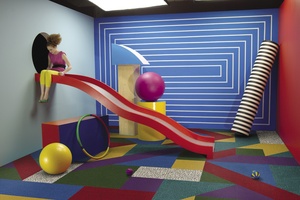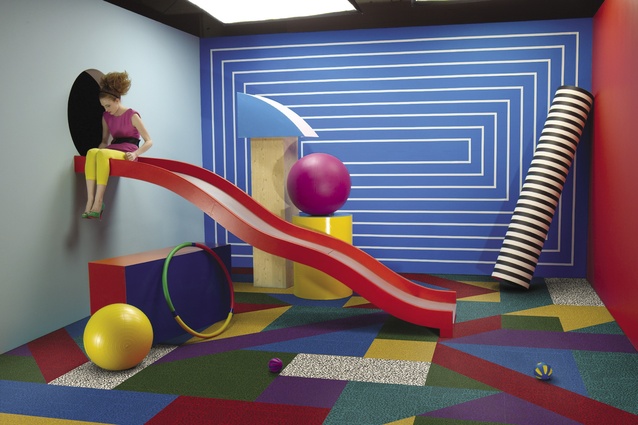Back to memphis
“Trends change so fast now,” says David Oakey in his distinctive southern American accent, before adding, “I’ve been more productive in the last five years than in the rest of my life.” That’s surprising, given the scope of his career, but you can pin that productivity on advances in technology. “I can sit in my bed on a Sunday morning, get on my computer and look at 23 new offices that went into London. I have images, products, colors, and I know what’s going on.
I can find trends now that I never could before. Before, I would be relying on salespeople – but did they take a photograph, did they go in, did they meet with an architect? It’s unbelievable now; it’s real-time.”
Trends are a primary focus of this conversation. The textile design specialist has the responsibility of working out ‘how we play’ – the ‘we’ being Interface, the ‘play’ being deciding what the carpet tile company he’s been consulting to for 15 years opts to manufacture in face of the touted zeitgeist. What do you design when there’s a millennial change in workforce make-up? The kids of yesterday, i.e. the millennials, are forming a workplace majority and the reason they’re different to any other generation is because technology has changed so much, leading to new ideas on how we work and live. The question, for Oakey, is: does flooring have a role to play in office organisation? It’s a rhetorical question, of course. As far as he’s concerned, flooring, and carpet tiles in particular, are as good, if not better, as any other type of office amenity at creating zones and spaces and those more ethereal concepts that make the office a place where people want to spend time.

Oakey’s home base is at the Pond – his studio in LaGrange, Georgia. And the designer has firsthand experience in the type of cultural change we’re talking about.
“We have interns that come in every year and work for us,” he says. “Over the last three years I’ve had to really change my management skills. At first, I was making them arrive at 8 o’clock, take an hour for lunch and leave at five – that’s what I expected. But then, as I’d wander through my office – and this group is usually working in one room together – I’d open the door and see them feet up, juggling balls, watching films, listening to music. I’m like, ‘what are you doing? Where’s the work?’ These are actually things that I’d say to them. For a while I was like ‘close the doors, don’t look, don’t even go in there’. Then I got to the stage where I’d say: OK, you’re doing an internship. Here’s your project, you can come in any time you want. So now they roll in at 10 or 11 o’clock and they’re usually there until 1, 2 or even 3 o’clock at night. Or they might do an all-nighter, depending on the project. They take their university habits straight into work. And they come up with unbelievable projects. For the mix of generations, though, it’s pretty tough.”
Oakey’s not been alone in figuring out this change. The question for corporates is how to attract the best staff, and then how to keep them. How does IBM compete with Facebook or Google? Gone, says Oakey, are the clean-lined award-winning projects of Skidmore or HOK. Here, are the chaotic interiors of companies like Zappos, an online shoe retailer that’s turned a model on its head by offering free delivery. You only pay for the shoes you keep. Oakey flashes up a photo of this office – which he cites as having the best customer service in the States – it’s a chaotic, high-energy environment.
“I was educated through architecture from Skidmore and HOK – all that minimal, clean design that wins awards. I think Skidmore and HOK would be horrified [at Zappos]. It’s now, what is good design? We’ve had our people go there to understand why their customer service is so good. Their sales are unbelievable; it’s one of the 15 best companies to work for, and it looks like it’s party time. So I’m suddenly in this world of ‘what are we supposed to be designing?’ It’s so diverse. We’ve been watching this, and so have some of the big furniture companies that are struggling because they’re used to building systems furniture at $10,000 dollars apiece, when now it seems like it’s bean bags and car tires.”
Oakey has a great anecdote that reflects the attitudinal change. “There’s a story we found in New York. This couple’s son got a job in Arizona. He calls up his parents and says, ‘I got my first job, but I think I did something wrong, they put me in a cubicle…’
And there’s another big trend to bear in mind. These days, 88 per cent of young people want to live in urban environments. “In China, you’re going to be forced to live in big cities; it’s the only way sustainability is going to happen.”
This demographic change has prompted a change in the way Interface is presenting itself. For the first time, the company is undertaking a more global approach to its marketing and supply.
“The trends are so fast now – it’s incredible; so it’s been a decision for Interface to really start to get hooked up. I’m going out and listening to needs; I’m listening to customers and working with the manufacturing people to understand their capabilities, what do we have in common; and next year, we will come out with the first global product range to be launched globally, all at the same time.”
So, where does Oakey find inspiration? It’s no surprise that it’s partly from young people and partly from his past. The inspiration for Memphis, a recent range, has it roots in both a trip to SoHo and Ettore Sottsass’s band of merry designers from the ’70s.
“We were at NeoCon and talking to the marketing people and they were saying, ‘We’ve got to have something inexpensive – plain products that we need to be able to sell and be very competitive’. I’m saying, no I think we’ve got to shake things up.”
In SoHo one day, Oakey and his wife found themselves surrounded by young people wearing fluorescent and primary colours, reminding him of Sottsass and the Memphis movement. A decision was made to pursue that line of inquiry; research ensued that focused on play and fun. What offices did people want to work in? What offices, importantly, would they stay working in?
For Oakey, it’s about landscapes.
“We have the most flexible, adaptable, cost-effective way to create zoning in a workplace. So if you want to find a fun little area, just drop some carpet tile in that area, a zone around casual furniture. It’s like a rug at home. So we can use this floorplate to create zoning areas, to change things faster and more flexibly than furniture. It’s using color and pattern – and we’re starting to design product now very differently.”
This recession-based return to Memphis makes sense, he says. “People can play with the Memphis collection and be as bold as they want, or make it more subtle.”
“You can take solid colors from another product line of texture, maybe add in a little pattern, and do it right on the floor. Memphis is the whole concept of playing with the products and seeing what you can create, and, as the world evolves and the economy slowly makes a comeback, people are demanding sustainable products made by responsible companies that are both beautiful and joyful. Let’s try to move past all this gloom and doom. Let’s talk about color and happiness.”
Oakey says that accent areas are going to be the most important, and predicts residential types of finishes in commercial interiors – “more pattern, more colour – you’ll see us come out with products that are very, very different.”
‘Creative nesting’ as he calls it, is about how flooring can impact on the human work experience. “It’s this young group here; it’s the collaboration, it’s creating zones and changing, and if you don’t like it, change it back, change your office. This is what we’re starting to think about – how flooring can change the office landscape.”
Sustainability

Proponents of sustainability are often painted as evangelical. Oakey is quite softly spoken but resolute, passionate. Interface founder, the late Ray Anderson, probably falls more into the evangelical camp. His books on sustainability have had a gospel-like effect on any number of corporate bosses.
Oakey credits Anderson with providing one of his two life-changing moments. The designer had just signed a three-year contract with Anderson when the Interface founder decided the company would become sustainable. That was a game changer, says Oakey, who also has a special interest in the field of biomimicry (bios, meaning life; mimesis, to imitate). He’s on the board of the Biomimicry Institute, and says that the institute’s founder, Janine Benyus, who visited New Zealand a few years back as part of a Better By Design CEO summit, provided him with life-changing moment number two when he read her book Biomimicry: Innovation Inspired by Nature. Biomimicry he says is like common sense. “We as humans have tried to command and control the earth, and you know we’ve got to a point now where I don’t think we can do it, we’ve got to fit in. In fact, as a species, if we were gone, the earth would heal itself so quickly it would be unbelievable.”
Oakey is keenly interested in the way we use the earth’s resources. “This is the most important thing. All our carpet is now made from waste. We’re making product from fishing nets dumped in the Med – that’s a big, big source of raw material. We’ve got our suppliers, such as the Italian Aquafill company, and Interface is making product in the US now that’s manufactured from 100 per cent waste. Here [in New Zealand] we’ll change mid-2012. This is the world we are; we are taking waste and creating beauty.”











